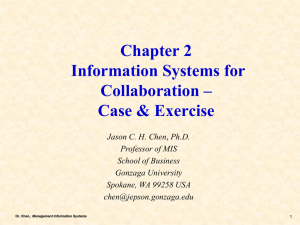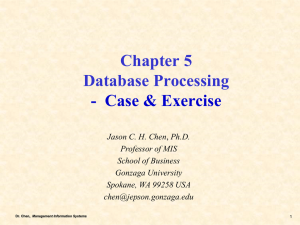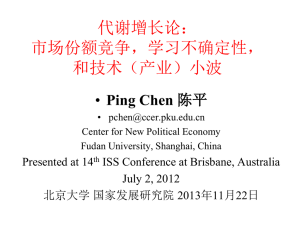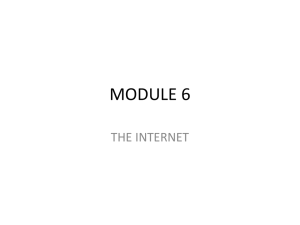ch06_summer - Gonzaga Student Web Server
advertisement
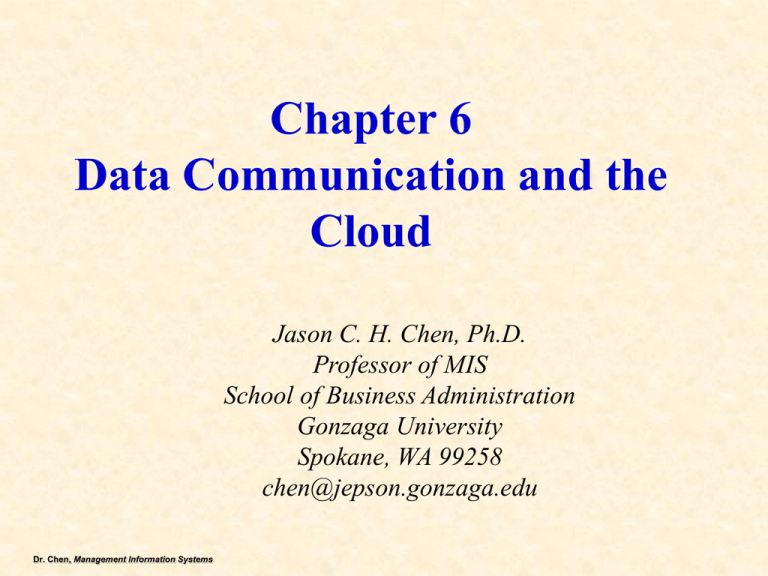
Chapter 6 Data Communication and the Cloud Jason C. H. Chen, Ph.D. Professor of MIS School of Business Administration Gonzaga University Spokane, WA 99258 chen@jepson.gonzaga.edu Dr. Chen, Management Information Systems GearUp Scenarios Chapter 4: Hardware and Software • GearUp has important decisions to make about critical software development project Chapter 5: Database Processing • GearUp does not have the easy access to data needed to analyze vendor quality and costs Chapter 6: Data Communication and the Cloud • GearUp needs to make decisions about building infrastructure for the next stage of its growth • GearUp needs to understand advantages and disadvantages of cloud-based computing Dr. Chen, Management Information Systems 2 GearUp: “No, I Mean 25 Cents an Hour.” • Gearup’s Web hosting costs rising rapidly • Lucas suggests provisioning Web servers and databases in the cloud • Provision server resources by the hour • Costs: $50/mo plus 25-cents per hour for processing time used • Could yield huge savings Dr. Chen, Management Information Systems Topics in Networks • Three popular networks – – – – LAN MAN WAN and Internet Dr. Chen, Management Information Systems Study Questions Q1: What is a computer network? Q2: What are the components of a LAN? Q3: What are the fundamental concepts you should know about the Internet? Q4: What processing occurs on a typical Web server? Q5: Why is the cloud the future for most organizations? Q6: How can organizations use the cloud? Q7: 2022? Dr. Chen, Management Information Systems Q1: What Is a Computer Network? • Computer network is a collection of computers that communicate with one another over a variety of transmission lines. • Three basic types of networks: LAN, WAN, and Internet. • What are the alternatives for a WAN?(video) Figure 6-1 Major Network Types Dr. Chen, Management Information Systems 6 Connecting to the Internet What Are the Alternatives for a WAN? • WANs connect computers located at physically separated sites by obtaining connection capabilities from a third-party, typically an Internet Service Provider (ISP). • Three primary functions of an ISP are to: 1. Provide users with a legitimate Internet address 2. Serve as a gateway for users to connect to the Internet 3. Help pay for the Internet by collecting money from customers and using it to pay access fees and other charges Dr. Chen, Management Information Systems 7 What is a computer network? • Network: a communications, data exchange, and resource-sharing system created by linking two or more computers with communication standards, or protocols, so that they can work together • Three major types of networks: – Local area network (LAN): computers connected at a single physical location, such as networks on GU campus. – Wide area network (WAN): Computers connected between two or more separated sites (locations) – The Internet and internets: Networks of networks Dr. Chen, Management Information Systems What Is a Computer Network? • Additional characteristics of networks: LAN communication lines reside on-premises, making it easier for a business to locate a network wherever it chooses. WAN communication lines are owned by a third-party vendor. A business contracts with vendor to use its WAN lines. Each type of network uses protocols which are sets of rules that two devices use to communicate with each other. Dr. Chen, Management Information Systems 9 Q2: What Are the Components of a LAN? SOHO LAN Figure 6-2 Typical Small Office/Home Office (SOHO) LAN Dr. Chen, Management Information Systems What Are the Components of a LAN? • Components are usually located within a half mile of each other. • A switch is a special-purpose computer that receives and transmits messages to computers in the LAN. • A network interface card (NIC) is a hardware component that connects each device’s circuitry to a cable allowing protocols to send data across the LAN. • Most computers today include an NIC. Fig 6 (extra): Local Area Network (LAN) Dr. Chen, Management Information Systems 11 What are the components of a LAN? A media access control (MAC) address serves as a unique identifier for each NIC on a LAN. Fig 6 (extra): Local Area Network (LAN) Dr. Chen, Management Information Systems Wired Connectivity: What Are the Components of a LAN? • Media access control (MAC) address serves as a unique identifier for each NIC on a LAN. • Unshielded twisted pair (UTP) cables, shown on left, are one way to connect devices to a LAN. • Optical fiber cables, shown on right, connect devices to a LAN using fiberglass wires to transmit signals which are light rays. Cladding contain the signals. Optical fiber carries more traffic than UTP cables. Fig 6-(extra) Unshielded Twisted Pair (UTP) Cable Dr. Chen, Management Information Systems Fig 6-5 Optical Fiber Cable 13 Question • In order for a printer or laptop to connect to a wireless LAN they must have a(n) – NIC or – Something else? Dr. Chen, Management Information Systems Wireless Connections: What Are the Components of a LAN? • IEEE 802.11 wireless protocol uses wireless NICs (WNIC) to connect devices to networks similar to how wired NICs operate. • Figure depicts a combination of NICs and WNICs on a LAN. • Access points (AP) use 802.3 protocol to communicate with a switch and 802.11 protocol to send and receive wireless traffic. Dr. Chen, Management Information Systems Fig Extra: LAN with Wireless 15 LAN Protocol IEEE 802.3 • Wired LAN • 10/100/1000 Mbps • Ethernet IEEEE 802.11 • Wireless LAN • 802.11n • Bluetooth Dr. Chen, Management Information Systems What Are the Components of a LAN? • The IEEE, Institute for Electrical & Electronics Engineers, is a committee that creates and publishes protocols and standards used by virtually every network. • IEEE 802.3, or Ethernet, protocol is used by all LAN devices. It specifies hardware characteristics and describes how messages are packaged and processed. • Onboard NICs in new PCs support10/100/1000 Ethernet protocol which describes transmission rate speed. • Communication speeds are expressed in bits like 1,000,000 for megabits. Dr. Chen, Management Information Systems 17 Summary of LAN and WAN Networks Figure 6-3 Network Technology Summary Dr. Chen, Management Information Systems Connecting to the Internet • Connecting personal computers to an ISP requires that digital signals coming out of the computer are converted to analog signals. Analog signals coming into a personal computer must be converted to digital signals. Comparison of digital and analog signals. digital signal (0/1) analog signal (wavy) Fig 6-4 Analog Versus Digital Signals Dr. Chen, Management Information Systems 19 What are the alternatives for a WAN? Modems are used to convert the signals back and forth as shown in the figure below. digital signal analog signal Fig 6-5 Personal Computer Internet Access Dr. Chen, Management Information Systems 20 Two Ways connecting to an ISP (for Homes and Small Businesses) • 1. DSL (Digital Subscriber Line) modem shares a single communication line for a telephone and a personal computer. It’s much faster than a dial-up modem and allows a user to maintain a constant network connection with an ISP. Asymmetric DSL, ADSL, provides different upload/download speeds. Symmetrical DSL, SDSL, provides the same upload/download speeds. • 2. Cable modem shares a single communication line for cable TV and a personal computer. It’s also faster than a dial-up modem and allows users to maintain a constant network connection. Because cable modems use a neighborhood distribution center, transmission speeds vary based on the number of network users. • DSL and cable modems are considered broadband because their transmission speeds exceed 256 kbps (narrowband is with the transmission speeds of less than 56kbps). Dr. Chen, Management Information Systems 21 Q3: What Are the Fundamental Concepts You Should Know About the Internet? Fig 6-6 Using the Internet for a Hotel Reservation Dr. Chen, Management Information Systems Video • Cloud_Computing_bmis235(4m50s) • TCP / IP - An animated discussion (6:12) • http://www.youtube.com/watch?v=RbY8Hb6abbg Dr. Chen, Management Information Systems 23 What are the functions of the five TCP/IP? • Throughout this chapter, and while you’re using the Internet, you’ll hear these terms used frequently. – Architecture is the arrangement of protocol layers with each given specific tasks. – Protocols are sets of rules that accomplish tasks in each layer. – Programs are specific computer products that implement protocols. Dr. Chen, Management Information Systems Five Layers of TCP/IP Protocols Application Layer USERS? Transport (TCP) Layer Software Developers Internet Protocol (IP) Layer Five Layers of TCP/IP Why Protocols TCP/IP Protocol? Dr. Chen, Management Information Systems Hardware Experts Data Link Layer Physical Layer 25 TCP/IP Protocol Architecture This chart gives you the specific and broad functions of each layer in the TCP/IP-OSI architecture. TCP or Transmission Control Protocol • Breaks traffic up into packets and sends each one along its way IP (Internet Protocol) Routers Dr. Chen, Management Information Systems Fig 6-7 TCP/IP Protocol Architecture TCP and IP Protocols: Middle Layers • TCP or Transmission Control Protocol • Breaks traffic up into packets and sends each one along its way • IP (Internet Protocol) • Routers Dr. Chen, Management Information Systems IP Addressing • Public IP Addresses • Identify a particular device on public Internet • Public IP addresses must be unique, worldwide • Assignment controlled by ICANN (Internet Corporation for Assigned Names and Numbers) • Private IP Addresses • Identify a particular device on a private network • Controlled by company operating network • Major benefits 1. Public IP: All devices on LAN share a public IP address. 2. Private IP address, need not register computer with ICANNapproved agencies. Dr. Chen, Management Information Systems Functions of the LAN Device • Switch processing: IEEE 802.3 wired LAN traffic • Access-point processing: IEEE 802.11 wireless LAN traffic • Translating between IEEE 802.3 and IEEE 802.11 • Converting between Analog and Digital • Assigning private IP addresses • Converting IP address between private and public IP addresses • Routing packets • And more … Dr. Chen, Management Information Systems Public IP Addresses and Domain Names IPv4 • Four decimal dotted notation like 165.193.123.253 Domain name • Worldwide-unique name affiliated with a public IP address • Affiliation of domain names with IP addresses is dynamic URL (Uniform Resource Locator) Dr. Chen, Management Information Systems Virtual Private Networks (VPN) • Virtual Private Networks (VPNs) create the appearance of private point-to-point connections by using tunnels to create virtual, private pathways over the Internet. • Figure below shows connections a VPN uses. Fig 6-9 Remote Access Using VPN: Actual Connections Dr. Chen, Management Information Systems 31 Why Do Organizations Use Virtual Private Networks? A VPN appears to be a direct connection between two sites as shown in this figure. Software encrypts data as they pass through the VPN making them more secure. Then, decodes when user receives them. Fig 6-10 Remote Access Using VPN: Apparent Connection Dr. Chen, Management Information Systems 32 Why Do Organizations Use Virtual Private Networks? This figure shows how a WAN uses three different VPN tunnels to connect geographically separated users. Secure but costly !!! One Solution: Web Server Fig 6-11 WAN Using VPN Dr. Chen, Management Information Systems 33 Q4: What Processing Occurs on a Typical Web Server? • Almost all e-commerce applications use the threetier architecture, which is an arrangement of user computers and servers into three categories, or tiers (see Fig. 6-13). – User tier: consists of computers, phones, and other devices that have browsers that request and process web pages. – Server tier: consists of computers that run Web servers and process application programs. – Database tier: consists of computers that run a DBMS that processes requests to retrieve and store data. Dr. Chen, Management Information Systems Three Tier Architecture for E-Commerce Applications Fig 6-13 Three Tier Architecture Dr. Chen, Management Information Systems DATABASE TRENDS Linking Internal Databases to the Web User tier Dr. Chen, Management Information Systems Database tier Server tier N 36 Web-Based Client/Server Database Architecture 2. Request for data-based Web page 1. Request for data-based Web page Network 8. Data-based Web page Web Browser 3. Data query 6. Retrieved data 7. Data-based Web page 4. Data query Web server 5. Retrieved data Legend Communications Between Web browser And Web server Database Server Dr. Chen, Management Information Systems Communications Between Web server And database server Watch the Three Tiers in Action! Dr. Chen, Management Information Systems Fig 6-12 Hypertext Markup Language (HTML) Dr. Chen, Management Information Systems Fig 6-15 XML, Flash, Silverlight, HTML 5 • XML (eXtensible Markup Language) • Fixes several HTML deficiencies • Program-to-program interaction over Web • Flash • Browser add-on for animation, movies, and other advanced graphics inside a browser. • Silverlight • Browser add-on with greater functionality than Flash • HTML 5.0 • Supports animation, movies, and graphics Dr. Chen, Management Information Systems Q5. Why Is the Cloud the Future for Most Organizations? • Cloud Elastic leasing of pooled computer resources over the Internet • Elastic Dynamically increasing/decreasing a leased resource programmatically in a short span of time, and only pay for resource used Dr. Chen, Management Information Systems Why Is the Cloud Preferred to In-House Hosting? Fig 6-17 Comparison of Cloud and On-Site Alternatives Dr. Chen, Management Information Systems Why Is the Cloud Preferred to In-House Hosting? (cont’d) Dr. Chen, Management Information Systems Fig 6-17 Comparison of Cloud and On-Site Alternatives When Does the Cloud Not Make Sense? • Only when law or industry standard practices require physical control over the data • Private cloud In-house hosting, delivered via Web service standards Dr. Chen, Management Information Systems Clouds • Cloud computing Refers to a computing network on the Internet When you access a video from a site like Facebook, you are accessing computing services in the cloud. You don’t know which server is processing your Facebook requests or which server is playing the video. You just know that somewhere in the cloud one or more servers are causing the video to be downloaded to your computer. Dr. Chen, Management Information Systems Cloud Service • Web Email • Online virus detection • YouTube • Online Doc • Blogging •… Dr. Chen, Management Information Systems 46 Dr. Chen, Management Information Systems Another Video for Cloud Computing http://www.salesforce.com/cloudcomputing/?fromSearch=true Dr. Chen, Management Information Systems 48 Q6. How Can Organizations Use the Cloud? Fig 6-18 Three Fundamental Cloud Types T/F: The most basic cloud offering is platform as a service (PaaS), which is the cloud hosting of a bare server computer or disk drive. Answer: Dr. Chen, Management Information Systems See page. 201 Q7: 2022? Cloud computing benefit • Individuals on iCloud • Small groups using Office 365 • Startups Using PaaS • Huge organizations using IaaS New categories of products and services Create new jobs? Tele-action • Telediagnosis, telesurgery, telelaw enforcement Dr. Chen, Management Information Systems • End of Chapter 6 Dr. Chen, Management Information Systems

